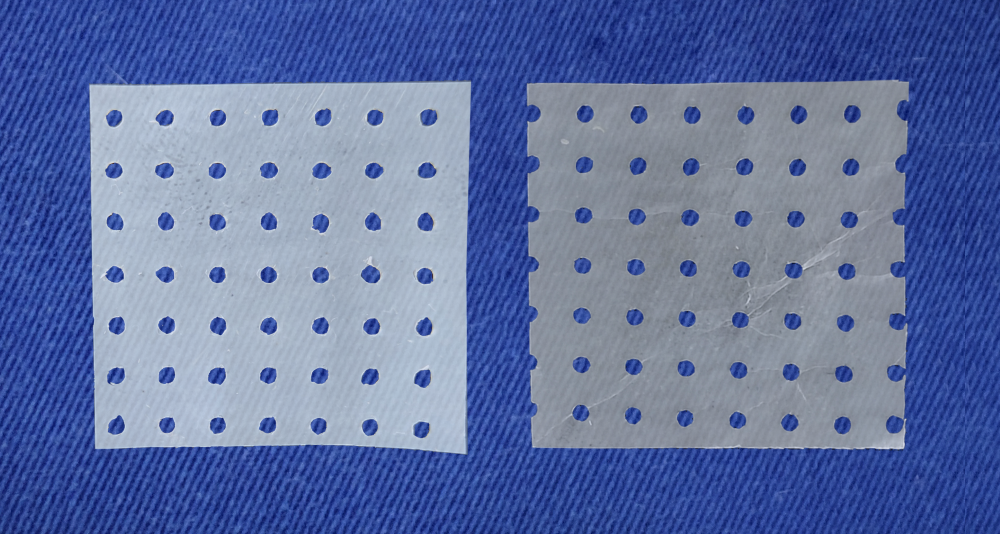


The dressing proved capable of fighting bacteria in complex skin wounds, virtually eliminating them in less than a month (photo: Saulo D. Ozelin/Mutagenesis Laboratory of the University of Franca)
Published on 03/17/2025
By Julia Moióli | Agência FAPESP – A cellulose dressing containing silver nanoparticles has been shown to reduce the concentration of bacteria in complex skin wounds, virtually eliminating them in less than a month of treatment without side effects. The promising results of the animal testing were published in the Journal of Pharmaceutical Sciences by Brazilian researchers affiliated with the Universities of Araraquara (UNIARA) and Franca (UNIFRAN).
The natural healing process of common wounds involves three stages (inflammation, proliferation and remodeling), lasts about one month, can be accelerated by a number of supportive treatments, and still profoundly affects the quality of life of millions of people around the world. In the case of chronic wounds, such as those resulting from burns, continuous pressure on a specific area (common in bedridden patients) and diabetes, which require specific therapies and procedures, the social and financial impact is even greater.
By way of illustration, the Brazilian Diabetes Society (SBD) estimates that about 13 million people in Brazil suffer from “diabetic foot” (ulcers on the lower limbs as a result of the disease). Expenditures for amputations due to these injuries in the SUS (“Sistema Único de Saúde”, Brazil’s national public health network) amounted to BRL 799 million between January 2012 and December 2022.
In this study, supported by FAPESP, scientists tested a dressing that combines the benefits of two treatments with proven efficacy in healing and improving the physiological conditions of wounds: silver nanoparticles, which have antimicrobial activity; and bacterial cellulose membranes, a biocompatible material made of nanofibers synthesized by gram-negative bacteria, which do not require the removal of injured tissue and help reduce the patient’s pain.
“Our idea was that the combination could enhance the biological activity of the products, increasing the effectiveness of healing and reducing the possible toxic effects of silver, which was confirmed after experiments,” says Saulo Duarte Ozelin, who developed the study during his doctoral studies at UNIFRAN.
Over a period of 21 days, a group of rats with wounds similar to those found in humans were treated with the nanomaterial-based dressing. For comparison, other animals received different therapies, including the use of the membrane alone, without the presence of silver. Specific tests analyzed the influence of the treatment on the extent of the wound, such as cell proliferation, local microbial growth, histopathological parameters and collagen content, as well as indicators of silver toxicity, such as weight gain, water consumption and biochemical analysis of kidney and liver function parameters.
Within 48 hours, the researchers observed that the dressing significantly reduced the number of microbial colonies compared to other treatments: “This result is extremely interesting because one of the main obstacles to healing is precisely bacterial contamination,” says Denise Crispim Tavares, professor at UNIFRAN and coordinator of the study. “With this reduction, the healing process is accelerated.”
After 14 days, the lesions had shrunk significantly. At the end of the experiments, the average rate of wound contraction was more than 97% compared to the initial area. There was also an increase in the amount of collagen fibers at the edge of the lesions, lower levels of necrosis, angiogenesis (the growth of new blood vessels from existing ones) and inflammation – without systemic toxicity.
“These results show that our dressing has the potential to offer patients a better quality of life and contribute to their well-being,” says Hernane da Silva Barud, professor at UNIARA’s Biopolymers and Biomaterials Laboratory, who is responsible for the development of the biomembranes.
Next steps
The bacterial cellulose membranes used in the study have been the focus of Barud’s research group at UNIARA for about 20 years and are part of a family of dressings already widely marketed by startups BioSmart Nano and HB Biotech, both affiliated with the university.
The new version, with the addition of silver, is already patented, but should soon enter the human clinical trials phase to reach the market.
“In addition to providing patients with the benefits seen in the animal study, producing such a dressing in Brazil guarantees cost savings over imported options and more effective quality control,” Barud believes.
The article “Nanocomposite Based on Bacterial Cellulose and Silver Nanoparticles Improve Wound Healing Without Exhibiting Toxic Effect” can be read at: www.sciencedirect.com/science/article/abs/pii/S0022354924001394.
Source: https://agencia.fapesp.br/54204